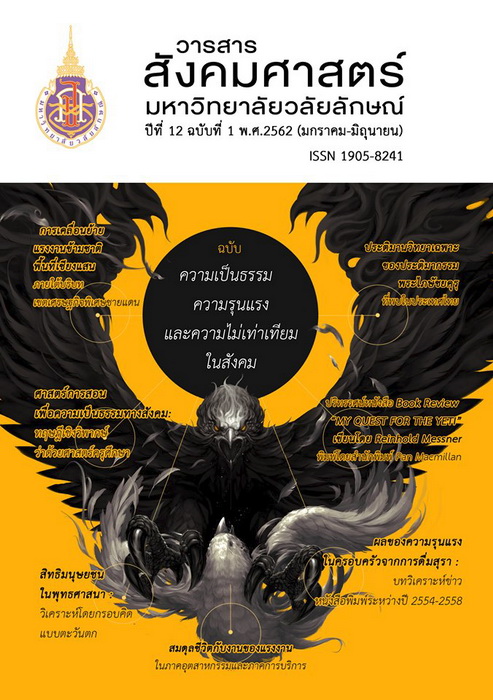Work-life Balance of Industrial and Service Labors
Main Article Content
Abstract
This article aims to examine factors influencing the work-life balance of industrial and service labours in Khon Kaen province, Thailand. The quantitative research methodology was utilized. The unit of analysis was individual level. The samples were 397 labours selected by systematic random sampling. The questionnaire was used as the tool for data collection in the workplaces. Data were collected from May to July 2018. Data were processed by binary logistic regression analysis to find Influencing factors to the work-life balance of industrial and service labours.
The results show that most industrial and service labours were female (75.3%), aged 19-38 years old, or so-called the generation Y (59.7%). Among the samples, 43.1 per cent were married and lived with a spouse. More than half had a formal education level lower than high school. As high as 74.1 percent of sample had less than 10 year experience working in industrial and service sectors and more thanhaft spent over 8 hours per day at work, that is, longer than regulatedby labour law. Regarding individual work-life balance, the resultsindicated the majority having medium and low level of balance at 76.6and 17.1 per cent, respectively. Four factors significantly influencedthe work-life balance of labours - age, working session in organization,working hours per day, and social support. All independent variablescan explain the variation of the work-life balance 29.1 percentages.(R2 = 0.291)
Article Details
Copyright: CC BY-NC-ND 4.0
References
Bruke, R. (2008). Organization Culture. Internet use for studying. Retrieved from https://www.sciencedirect.com/topics/ medicine-and-den-tistry/organizational-culture
Baupeng, P. (2011). Factors affecting organizational commitment of employee of Daikin industries Thailand., Ltd. (Master’s thesis). Rajamangala University of Technology Thanyaburi.
Buaphan, S. (2011). Work-life balance of personnel in the academic support unit, faculty of commerce and accountancy, Thammasat University. (Master’s thesis). Thammasat University.
Cobb, S. (1976). Social support as a moderstor of life stress. Psychosomatic Medicine, 38(1), 300-313.
Chaorungrot, P. (2015). Emotional intelligence and organizational support to predict the balance life and work of employees. (Master’s thesis). King Monngkut’s University of Technology North Bangkok.
Dolly, D. (2015). Measuring work life balance among the employeesof the insurance industry in India. International Journal ofAdvanced Research in Management and Social Sciences,4(5), 140-151.
Etzioni, E. (1999). Organizational commitment: The utility of anintegrative definition. Journal of Applied Psychology, 15(1),23-30.
Edward, J. R., & Rothbard, N. P. (2010). Mechanism linking work andfamily: Charifying the relationship between work and familyconflicts. Academy Of Menagement Review 25(1), 178-199.
Fisher, G., Stanton, J., Jolton, J., & Gavin, J. (2003). Modelling therelationship between work life balance and organisationaloutcomes. The Annual Conference of the Society forIndustrial-Organisational Psychology. University of Michigan. P.O.
Guest, D. E. (2002). Perspectives on the Study of Work-life Balance.Social Science Information, 41(2), 255-279.
Greenhaus, J. S, Collins, K. M., & Shaw, J. D. (2003). The relationbetween work family balance and quality of life. Journal ofVocational, 63(1), 510-531.
Gibson, R. C. (1991). Race and the self-reporter health of elderlypersons. Journal of Gerontology Social Sciences, 46(1),235-242.
Gray, R. (2016). Quality of life, work and happiness. MahidolUniversity, Bangkok: Institute for Population and Social Research.
Hewitt, A. (2013). Aon Hewitt’s Model of Employee Engagement.Retrieved from https://apac.aonhewitt.com/document-files/thought-lead-ership/people-and-performance/model-of-employee-engagement.pdf
Holumyong, C. (2017). Work, Family and Society: A work-life balancethat involves more than just time management of workersin the industrial production sector. Engineering journalKasetsart, 19(2), 87-102.
Hey Group. (2012). The latest survey work-life balance affectingturnover of employees around the world. Retrieved from https://www.haygroup.com/th/press/details.aspx
Jungtrakun, J. (2010). Quality of work life. Retrieved from https://www. blci-group.com/backend/work/file/09820221557.pdfKaewkiattikun
K. (2008). Work-life balance. Human Resource, 4(1),36-45.
Lamaisri, S. (2012). Thai industrial labor force stability: A case studyof Samut Prakan province. (PhD Thesis). Valaya Alongkorn Rajabhat University.
Ministry of Industry. (2016). Data of factory’s industrial Khon Kaenprovince. Retrieved from https://www.industry.go.th/khonkaen/index.php/download/22217-2559?path=
Marx, C. (1884). Economics: Critical Assessments. Retrieved from https://books.google.co.th/books?id=mhT4li_KMosC&pg=PA327&lp-g=PA327&dq=marx+1884&source=bl&ots=0kIW-xJiky&sig=ACfU3U2JV3ODYRbr1nV7hk1WXEmkly
Noobhut, J. (2011). Work-life balance in case Vibhavadi hospital.(Master’sthesis). Thammasat University, Thailand.
Nuanlaong, P. (2012). Social support and work life balance offactory workers in Songkhal province. (Master’s thesis). Songkla University, Thailand.
Purohit, M. (2013). A Comparative study of work life balance invarious industrial sectors in PUNG region. Retrieved from https://indianresearch-journals.com/pdf/IJMFSMR/2013/March/19.pdf
Padmasiri, M. K. D. (2016). Impact of Demographical Factors on WorkLife Balance among Academic Staff of University of Kelaniya, Sri Lanka. Journal of Education and Vocational Research,7(1), 54-59.
Raengsuwan, D. (1998). Industry in Thailand. Bangkok. Thailand.
Steers, R. M. (1977). Antecedents and outcomes of organizationaleffective-ness. Administrative Science Quarterly, 22(1),45-47.
Voydanoff, P. (2005). Work Demands and Work-to-Family and Family-to-Work Conflict. Journal of Family Issues, 12(1),15-26.
Yokying, P., Sangaroon, B., Sushevagul, T., & Floro, M.S. (2016). Work-life balance and time use: Lessons from Thailand. Asia-Pacific Population Journal, 31(1), 87-107.


